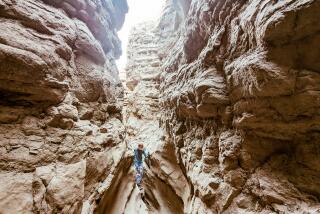Modest-Sized Mountain Has Big Claim to Fame
As mountains go, this one is a mere pimple. But according to local legend, the sweeping views from Mt. Diablo are surpassed by only one mountain on the planet: Kilimanjaro.
Diablo is near the Bay Area suburb of Walnut Creek and tops out at 3,849 feet. Mt. Kilimanjaro, by contrast, soars above the plains of Tanzania to a height of 19,335 feet.
Yet the improbable claim about Diablo has persisted nearly a century and can still be found in many hiking guides. Although the legend has a tenuous connection to the journal of a 19th century explorer, more likely it began with the boast of a 20th century real estate promoter.
Diablo is dwarfed by scores of mountains in the state, but the remarkable views from atop it have made the comparison with Kilimanjaro hard to dismiss.
“It’s like every legend; you can’t kill it with a stick,” said Mike Rodriques, the interpreter at Mt. Diablo State Park, gazing through binoculars from the summit at distant landmarks.
Diablo sits on the western rim of the Central Valley and is the biggest landmark around. There are no other nearby peaks of comparable size to block the view, as is often the case in ranges with numerous summits.
Unfolding to Diablo’s east are sweeping vistas of the San Joaquin and Sacramento rivers, which merge to form the San Francisco Bay Delta.
Beyond the valley the snow-covered Sierra Nevada, including Mt. Lyell in Yosemite National Park, is visible, as are the peaks of the Desolation Wilderness near Lake Tahoe. On exceptionally clear days after winter storms, it’s also possible to see Half Dome in Yosemite.
Using binoculars, Rodriques swung to the northeast and pointed to a tiny white speck. “That’s Mt. Lassen,” he said. The 10,457-foot peak is about 175 miles away.
The curvature of the Earth should permit visitors to see only 75 miles or so, but the peaks of the Sierra are so tall they rise above the horizon. Some visitors have said it’s possible on certain days to see a mirage of 14,162-foot Mt. Shasta -- 240 miles to the north -- because of a phenomenon known as atmospheric refraction, in which light rays are bent and views are extended.
The views from Diablo vary with the weather, but are usually best in winter and early spring. On the clearest days, it’s possible to see into about 20 of California’s 58 counties.
On the other hand, when morning fog envelops the Bay Area to the west, it is not always possible even to see all of San Francisco Bay, downtown San Francisco, the Golden Gate Bridge or the Farallon Islands, 27 miles off the coast.
The legend about Diablo’s views dates back to some of California’s earliest explorers. William Brewer, a Yale botany professor, visited the summit in the 1860s as part of one of the earliest efforts to take an inventory of California’s topography, flora and fauna. He raved about Diablo in his journals, which were later published. “The view was one never to be forgotten,” he wrote. “Few views in North America are more extensive -- certainly nothing in Europe.”
By 1915, a road for automobiles was completed to the summit. In the early 1920s, an entrepreneur who dreamed of building thousands of homes on Diablo’s western flanks began printing fliers that included the Diablo-Kilimanjaro boast. The homes were never constructed.
At least one nonbeliever has worked hard to debunk the legend of Diablo. He is Edward Earl, a 39-year-old engineer in San Diego and an accomplished mountaineer who relies on his math skills. Earl takes math so seriously that he has been nicknamed 7.389056099, which is the square of a number known as “e” that’s the basis for many logarithms. E.E. are his initials.
Earl first heard the Diablo legend in 1991 and was immediately skeptical. It just didn’t make sense to him that such a puny mountain -- no matter how ideally situated -- was in the same league with towering Kilimanjaro when it came to views.
It wasn’t until 1994 that Earl sat down and worked through the problem. By his calculations, it’s possible to see only 13,000 to 21,000 square miles of land and water from Diablo. By contrast, Mt. McKinley overlooks 60,000 to 70,000 square miles, Mauna Kea 59,000 square miles (including ocean) and Pikes Peak nearly 28,000 square miles.
“The fact that Diablo’s view is unobstructed is not enough to overcome the fact that Diablo isn’t that big in the first place,” said Earl, who thinks that at least 100 U.S. peaks offer better views. He said he can recall superior views from taller California mountains, including Shasta, Telescope Peak in Death Valley and White Mountain near Bishop.
Officials at Mt. Diablo State Park haven’t quite figured out how to explain the legend to visitors. Rangers suspect that the boast is false, and their suspicions are bolstered by several exhibits in the park museum pointing out that basic geometry supports the idea that you see more land from the top of a big mountain than from a small one.
Rodriques said the Diablo legend reminds him of the phrase “I’m going to see the elephant,” which was used by Gold Rush miners. The elephant was meant to symbolize California and all that was supposedly grand and super-sized about it.
“You don’t want to lie to folks,” said Rodriques. “People ask about it all the time, and I’ll say I don’t think the legend is true, but there really is no proof one way or the other.”
And then he added: “Of course, I want it to be true.”
More to Read
Sign up for The Wild
We’ll help you find the best places to hike, bike and run, as well as the perfect silent spots for meditation and yoga.
You may occasionally receive promotional content from the Los Angeles Times.






